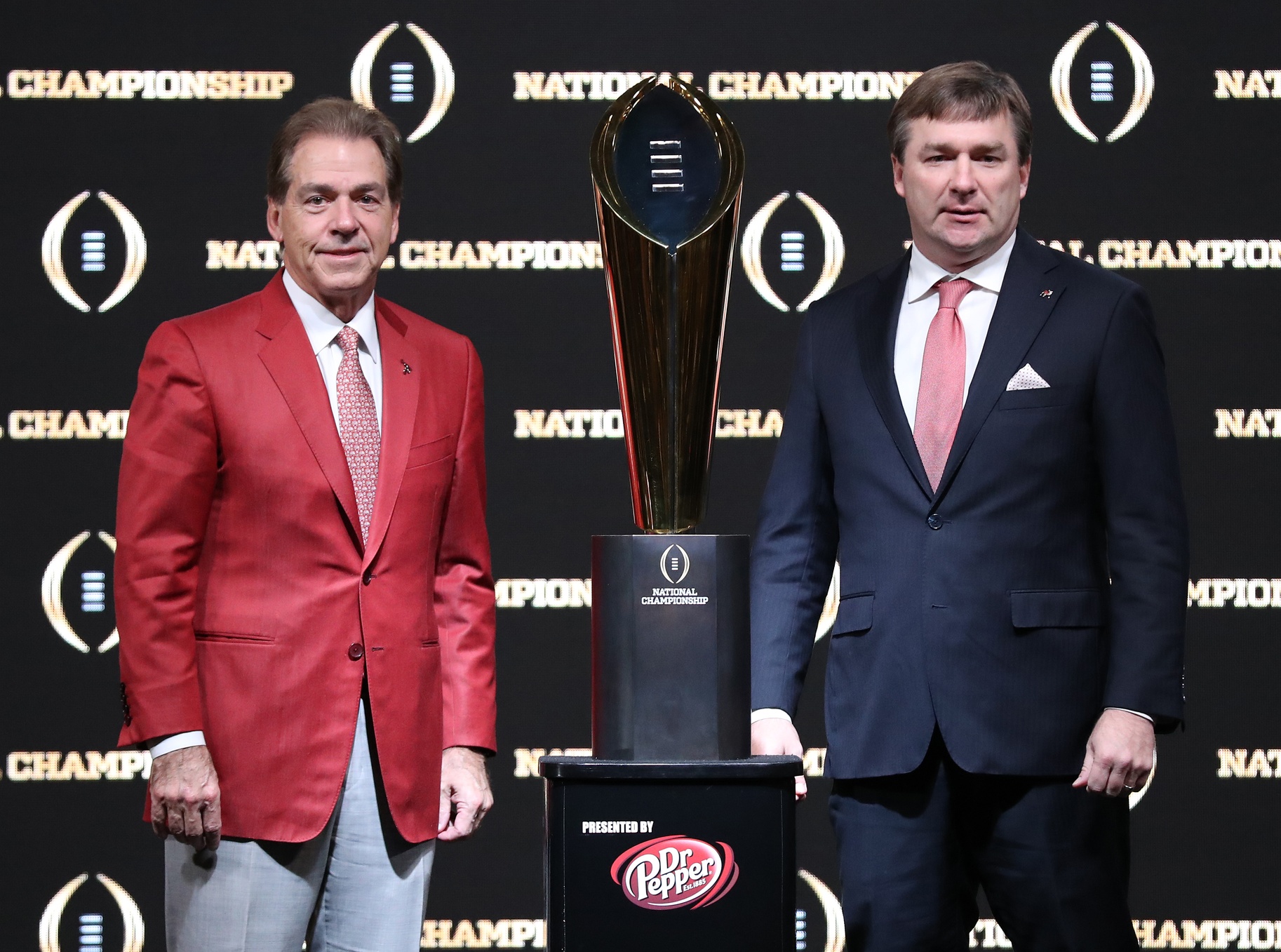
The new quad system is all the rage in college hoops; how would it have impacted the SEC/Playoff picture?
In case you haven’t heard, the new quad system what everyone is talking about in college basketball these days. Well, at least when they aren’t talking about FBI probes.
College basketball is trying a transparent method to make its NCAA Tournament selection process easier. In other words, it’s trying to take the subjectivity out of making the field. You can find your team’s quad score here. The team pages update daily.
Teams get more credit for “Quad 1 wins” as opposed to beating up on that random all boys college with 2,000 students from Indiana (that’s a Quad 4 win). That concept isn’t exactly new. The use of this system is new.
It couldn’t have come at a better time for the SEC, which has programs like Alabama and Texas A&M (they both have 11 Quad 1/2 wins apiece) benefitting despite the fact that they have 13 and 11 total losses, respectively.
If you haven’t seen exactly how the quads are broken up, here’s a good breakdown (via vuhoops.com):

That got me thinking. What would a quad system look like for college football?
Obviously it’s not a straight translation because RPI doesn’t exist and there are roughly one third the amount of FBS football programs as there are Division I basketball programs, but there’s gotta be a way, right?
Well, I believe I came up with a quad system that makes a lot of sense. If the Playoff selection committee simply wants to use it and give me a royalty check for every time it’s used and talked about, I’d be fine with that.
Here’s what it would look like:
- Quad 1 — home vs. Associated Press top 10, neutral site vs. AP top 25, road vs. AP top 30
- Quad 2 — home vs. AP 10-25, neutral site vs. unranked P5 w/above .500, road vs. unranked P5 above .500
- Quad 3 — home vs. unranked P5, neutral site vs. unranked P5 w/ .500 or less, road vs. unranked P5 at/below .500, road vs. G5 w/ winning record
- Quad 4— home vs. unranked G5, neutral site vs. G5 w/.500 or losing record, road vs. G5 w/.500 or losing record
With those metrics in mind, a Quad 1 win is worth +4 while a Quad 1 loss is worth -1. Then a Quad 2 win is worth +3 and a Quad 2 loss is worth -2 and so on.
So how would it have looked if that logic was applied to a handful of SEC teams in 2017? And perhaps more important, would the Playoff picture have looked any different? I’m glad you asked.

Keep in mind that I used the final, pre-bowl AP rankings to determine which Quad teams fell into. That means conference championships were included but obviously bowl games were not. If we want to actually apply this to the Playoff selection process, that timing made the most sense.
Just to show you the spectrum of this system, let’s start with the SEC team that failed to win a game:
Tennessee
- Neutral site vs. Georgia Tech: Quad 3 Win
- Indiana State: Quad 4 W
- at Florida : Quad 3 L
- UMass: Quad 4 W
- Georgia: Quad 1 L
- South Carolina: Quad 3 L
- at Alabama: Quad 1 L
- at Kentucky: Quad 2 L
- Southern Miss: Quad 4 W
- at Mizzou: Quad 2 L
- LSU: Quad 2 L
- Vanderbilt: Quad 3 L
So then here’s how Tennessee’s scoring would work:
- Quad 1: 0-2 (+0)
- Quad 2: 0-3 (-6)
- Quad 3: 1-3 (-7)
- Quad 4: 3-0 (+3)
- TOTAL = -10
OK, so for the rest of this discussion, we’ll focus on teams that were at least in the SEC title hunt and/or Playoff discussion late in the season.
Auburn is an interesting case because even with 2 losses, the Tigers were in position to earn a Playoff berth with an SEC Championship. That obviously didn’t happen, though. Still, here’s what Auburn’s quad system scoring would’ve looked like even with the Georgia loss:
Auburn
- Georgia Southern: Quad 4 W
- at Clemson: Quad 1 L
- Mercer: Quad 4 W
- at Mizzou: Quad 2 W
- MSU: Quad 2 W
- Ole Miss: Quad 3 W
- at LSU: Quad 1 L
- at Arkansas: Quad 3 W
- at Texas A&M: Quad 2 W
- Georgia: Quad 1 W
- UL Monroe: Quad 4 W
- Alabama: Quad 1 W
- Neutral site Georgia: Quad 1 L
And here was the final scoring:
- Quad 1: 2-3 (+5)
- Quad 2: 3-0 (+9)
- Quad 3: 2-0 (+4)
- Quad 4: 3-0 (+3)
- TOTAL = +21
Compared to Tennessee, +21 looks like a pretty solid score. It is. In fact, had Auburn beaten Georgia in the SEC Championship, the Tigers would have had more points and been clearly worthy of a Playoff spot.
Speaking of Georgia, here’s how the quad system would have looked with that huge conference title win:
Georgia
- Appalachian State: Quad 4 W
- at Notre Dame: Quad 1 W
- Samford: Quad 4 W
- Mississippi State: Quad 2 W
- at Tennessee: Quad 3 W
- at Vanderbilt: Quad 3 W
- Mizzou: Quad 3 W
- Neutral site Florida: Quad 3 W
- South Carolina: Quad 3 W
- at Auburn: Quad 1 L
- Kentucky: Quad 3 W
- at Georgia Tech: Quad 3 W
- Neutral site Auburn: Quad 1 W
Georgia clearly deserved its Playoff spot:
- Quad 1: 2-1 (+7)
- Quad 2: 1-0 (+3)
- Quad 3: 7-0 (+14)
- Quad 4: 2-0 (+2)
- TOTAL = +26
Let’s get to the more interesting discussion. That is, would Alabama have earned a Playoff spot in the quad system?

A lot was made about the quality of the Tide’s wins compared to Ohio State. Instead of just focusing on wins vs. top-10 teams (which some believed was the only important metric), here’s Alabama’s entire schedule with the quad system applied:
Alabama
- Neutral site FSU: Quad 3 W
- Fresno State: Quad 4 W
- Colorado State: Quad 4 W
- at Vanderbilt: Quad 3 W
- Ole Miss: Quad 3 W
- at Texas A&M: Quad 2 W
- Arkansas: Quad 3 W
- Tennessee: Quad 3 W
- No. 18 LSU: Quad 2 W
- at No. 19 MSU: Quad 1 W
- vs. Mercer: Quad 4 W
- at Auburn: Quad 1 loss
How many points would that have given the Tide?
- Quad 1: 1-1 (+3)
- Quad 2: 2-0 (+6)
- Quad 3: 5-0 (+10)
- Quad 4: 3-0 (+3)
- TOTAL = +22
Now I know what Alabama fans would say. Having a win over FSU on a neutral site being worth as many points as beating Tennessee at home seems crazy. I hear you loud and clear. The system isn’t perfect.
But judging teams based on where they finish instead of their current ranking at the time of the game makes more sense. It’s just using more data to evaluate a team. Did that obviously hurt Alabama because FSU fell off the rails? Absolutely, but this is an objective system.
That’s important to remember because who do you think is the next team I’m going to break down? Ohio State, of course:
Ohio State
- at Indiana: Quad 3 W
- Oklahoma: Quad 1 L
- Army: Quad 4 W
- UNLV: Quad 4 W
- at Rutgers: Quad 3 W
- Maryland: Quad 3 W
- at Nebraska: Quad 3 W
- Penn State: Quad 1 W
- at Iowa: Quad 2 L
- Michigan State: Quad 2 W
- Illinois: Quad 3 W
- at Michigan: Quad 1 W
- Neutral site vs. Wisconsin: Quad 1 W
And now, the moment of truth …
- Quad 1: 3-1 (+11)
- Quad 2: 1-1 (+1)
- Quad 3: 5-0 (+10)
- Quad 4: 2-0 (+2)
- TOTAL = +24
Yes, Ohio State would have made the Playoff over Alabama if this quad system had been applied. Even if you want to just focus on Quad 1 + Quad 2 wins, OSU has the advantage there.
What this doesn’t take into account, though, is the importance of the non-conference showdowns. The selection committee values that greatly. Not having a quality non-conference win is a major deterrent, as are blowout losses. That’s the other thing this doesn’t account for. While the quad system had Ohio State’s loss at Iowa only at -2, the selection committee basically had minus infinity because there wasn’t any way the Buckeyes were making the field after that happened.
Still, it would’ve been fascinating to see if the selection committee would’ve stuck with this scoring system or if it would’ve basically thrown it out the window if the situation presented itself.
OK, so I have just one more team that I need to show because whether you agree with it or not, it was a topic of discussion. For some people it is still a topic of discussion.
Yes, I’m talking about UCF.

The gripe with the current system is that it favors Power 5 teams. I would argue that my quad system also favors Power 5 teams. After all, a 10-win Group of 5 team that’s unranked doesn’t move the needle at all. That’s a Quad 3 win at best.
One would think that UCF, which failed to play a ranked Power 5 foe, would be hurt from the quad system. Interestingly enough, that wasn’t the case:
UCF
- FIU: Quad 4 W
- at Maryland: Quad 3 W
- Memphis: Quad 2 W
- at Cincy: Quad 4 W
- East Carolina: Quad 3 W
- at Navy: Quad 3 W
- Austin Peay: Quad 4 W
- at SMU: Quad 3 W
- UConn: Quad 4 W
- at Temple: Quad 3 W
- USF: Quad 2 W
- Memphis: Quad 2 W
So before you get upset at this, Alabama fans, remember that UCF’s scoring is BEFORE the Peach Bowl win against Auburn:
- Quad 1: 0-0
- Quad 2: 3-0 (+9)
- Quad 3: 5-0 (+10)
- Quad 4: 4-0 (+4)
- TOTAL = +23
That’s right. Believe it or not, the quad system would’ve given UCF (+23) the edge over Alabama (+22). And in case you wanted to say that Alabama was hurt by things outside of its control because FSU was only a Quad 3 win, Hurricane Irma wiped out UCF’s potential Quad 3 win vs. Georgia Tech that wasn’t made up on the schedule.
Is that my way of saying that UCF would have beaten Alabama on a neutral site? Of course not. I’m not even saying that UCF was necessarily more deserving of Alabama to make the Playoff.
But goodness gracious, selection committee. Sticking UCF at No. 12 (!) in the final Playoff rankings (pre-bowl) was an absolute cop out. That was entirely subjective. UCF had a better case than Penn State (+19 with just 2 Quad 1/2 wins). Actually, the Knights had almost the exact same point breakdown as USC (+23 with 3 Quad 1/2 wins).
So what did this teach us? Well, there might be a way to look at the Playoff selection process in completely unbiased fashion. Trusting a system like this would wipe out any cries of bias. It would make the entire résumé count and not just the parts that people want to pick and choose to fit their narrative.
I’m not here to say that we should take all of college basketball’s ways and apply them to college football. Lord knows college hoops are far from perfect right now (as is college football).
But maybe it is time to rethink the Playoff selection process. Either that or we can just get into endless arguments until the end of time.
Connor O'Gara is the senior national columnist for Saturday Down South. He's a member of the Football Writers Association of America. After spending his entire life living in B1G country, he moved to the South in 2015.







